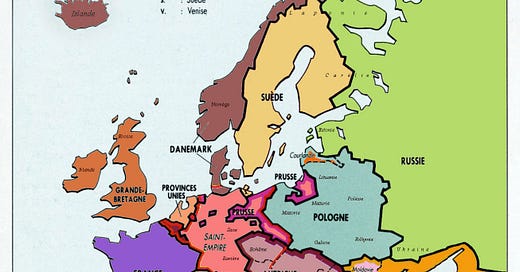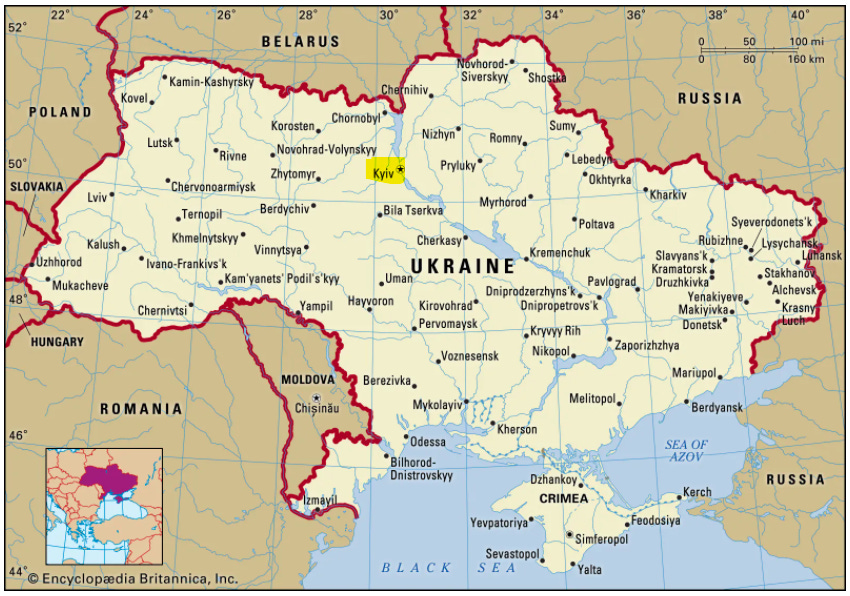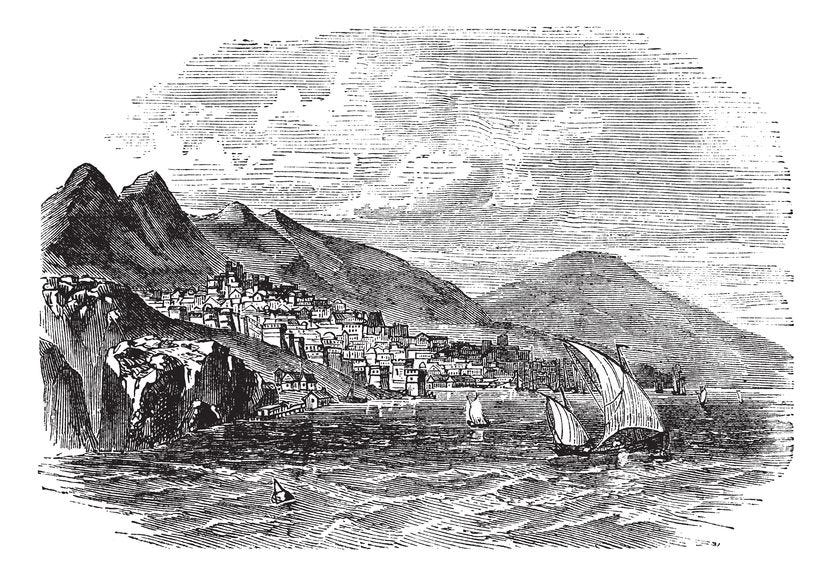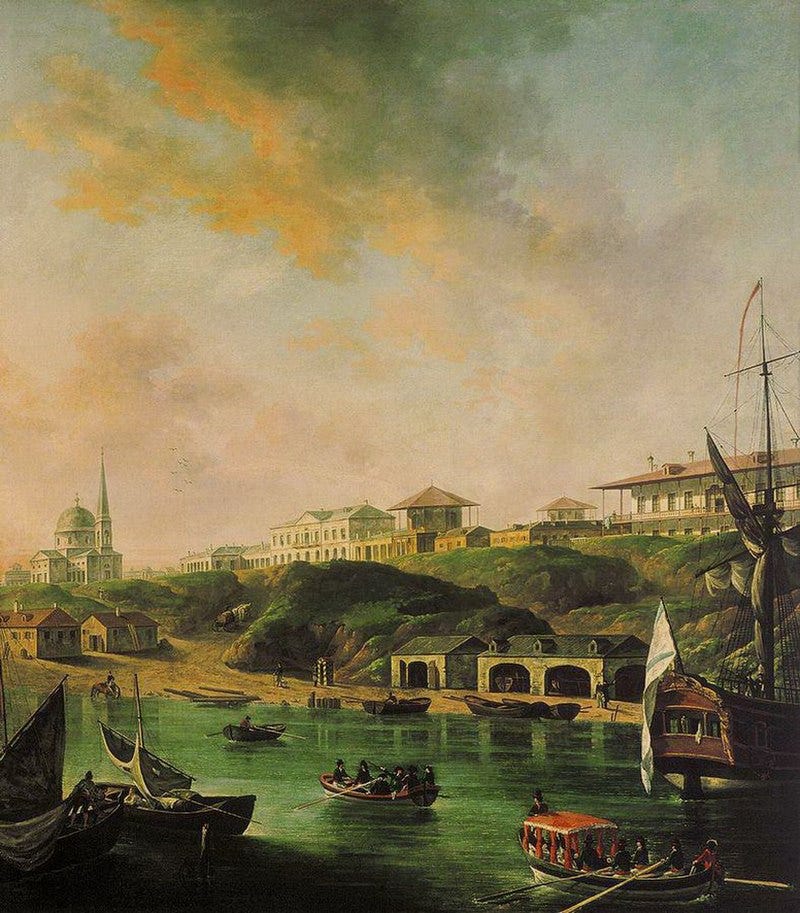A lie has been told, and they’re counting on you not being able to catch it.
There is no great historical nation called Ukraine. There never was. As a nation, Ukraine never existed in history, except for a brief period during World War I when some Ukrainians declared independence, only to be put down by the Bolsheviks a few months later.
The Ukraine was a region of Russia. That’s what it always was. And it was a small region. Not 200 miles across.

The word Ukraine, in both Russian and Ukrainian, means “borderlands.” It was always preceded by the definite article “the” because it was a region – “the borderlands,” in other words.
What borderlands? The ones on Russia’s southwestern border.
Ukraine, as we now know it, was a brand new creation in 1991, created when Boris Yeltsin signed some papers at a country house in the woods of Belorussia on December 8, turning the Ukrainian Soviet Socialist Republic into a nation called Ukraine.
“He sold off the whole country in a single night” Russian far-right leader Vladimir Zhirinovsky said in his famous speech in the Crimea in 2014.
The republic of Ukraine had been hastily thrown together by the Soviets. They’d taken various lands and thrown them together in the way you might throw unrelated items into a box when you’re packing and in a hurry and have nowhere else to put anything.
Lviv, in the west, was the Polish city of Lvov that the Soviet Union had acquired in World War II. The Crimean peninsula in the south had been Russian since 1783 and had been known as the vacationland of the Russian tsars since the 1800s. Odessa was a Russian port city founded by Grigory Potemkin, working in the service of the Russian empress known as Catherine the Great. And on and on…
But it’s not just these certain places. Reading the history of Russia, you realize that if not for Russians, the entire area that is now Ukraine would have remained under the control of the Mongols, who came from the east and swept across southern Russia, ransacking cities, including Kiev, in the 1200s. The Mongols of the Golden Horde controlled most of what is now Russia and Ukraine for more than 200 years.
It was Ivan III, grand prince of Moscow, who broke the so-called “Mongol yoke” in 1480 by refusing to pay tribute to the Mongol leader, the “khan,” thus calling his bluff. And it was Russian empress Catherine the Great who in the 1700s set out to take the Crimea and all of the area on the north coast of the Black Sea from the Tatars – Muslims who had mixed with the Golden Horde and were allied with the Ottoman Turks.
She had to do it.
The Tatars were killers, kidnappers and rapists.
They did not farm. They made their living by raiding villages in southern Russia and Poland and kidnapping their inhabitants, marching them down to Caffa, the ancient city on the south coast of the Crimea, to be taken to Constantinople and sold as slaves in the Jewish-run slave markets there.
More than 2 million Russians, Poles and Lithuanians were kidnapped and sold into slavery by the Tatars over 200 years, according to some estimates, and hundreds of villages in southern Russia were destroyed and abandoned.
More than 200,000 girls and young women were taken into bondage and sold into sex slavery, where, as we would now put it, they were raped for the rest of their lives.
Slavic girls and young women were especially prized by the Turks and the Arabs for their light skin and were sold for the highest prices. They were sold naked, to be displayed to potential buyers without a stitch of clothing to hide their shame.
The old men kidnapped by the Tatars were often disposed of more quickly. An eyewitness, the ambassador from the Holy Roman Empire, Sigismund von Herberstein wrote:
“old and infirmed men, who will not fetch much at a sale, are given up to the Tatar youths, either to be stoned, or to be thrown into the sea, or to be killed by any sort of death they might please.”
Younger men were often castrated, or had their ears cut off.
The Lithuanian ambassador to Caffa described it as “not a town, but an abyss into which our blood is pouring.”
A traveler from the Ottoman Empire described the Tatar slave market in another Crimean town called Karasubazarin:
“A man who had not seen this market had not seen anything in this world,” he wrote. “A mother is severed from her son and daughter there, a son — from his father and brother, and they are sold amongst lamentations, cries of help, weeping and sorrow.”
Catherine’s conquest of the Crimea and the entire Black Sea area was the necessary and courageous act of a leader who used her power to stop the exploitation, rape and slaughter of millions of her people and to secure for them a peace that would allow people again to settle these lands, to farm and build communities and prosper.
“All I hope, all that I wish is that this country in which God has cast me, should prosper. God is my witness to that,” Catherine wrote years later in notes appended to her memoirs. “The glory of this country is my glory.”

In taking these southern lands from the Tatars and Ottoman Turks, Catherine had also opened Russia to the Black Sea, which connects to the Mediterranean and the entire western world and north Africa. And having claimed this territory, on her orders the cities of Kherson and Nikolaev were built and plans drawn up for the city of Odessa.
Catherine also expanded the empire to the west, taking huge pieces of Polish territory in what is known as the Partition of Poland. She did it strategically, by arranging for her former lover, a native Pole, to become king, and then, sending troops into Poland and striking deals with both the Austrians and the Prussians, so that they all three claimed pieces of Polish territory that were nearest to them. By 1795, Russia had acquired all of what is now Latvia and Lithuania, plus the cities of Brest and Minsk and Zhitomir and Lutsk.
Before the partition, Kiev was about 10 miles from Poland. After the third partition in 1795, Kiev was more than 100 miles from the Polish border.
(the city of Kiev is spelled “Kijov” on the Polish map below)

Almost everything that is now Ukraine is land that Catherine the Great took for Russia.
What land did a nation called Ukraine fight for and win? You can look, but you won’t find much, if any.
And Kiev is almost a topic onto itself. For Kiev, for Russia, is not a distant foreign capital. It’s the birthplace of Russia more than 1,000 years ago.
The nation of Russia began in Kiev, where stands one of the most glorious cathedrals in all of Christendom – the St. Sophia cathedral, built in the time of the Great Prince of Kiev, Yaroslav the Wise, in the year 1011.
Look up the oldest church in the United States and you will see a small structure built of mud and bricks that was built in about 1610.
Look up the St. Sophia cathedral in Kiev and you will see a magnificent white-walled church crowned with 13 gold-planted onion domes. The interior is covered in frescoes that extend 60 feet into the air and cover the arched ceilings, supported by columns of porphyry, marble and alabaster.
In her memoirs, Catherine describes her visit to St. Sophia while still a teenager engaged to the future tsar, saying: “I have never been so struck by anything as I was by the magnificence of that church, where all the images are covered with gold, silver and jewels.”
She’d traveled to Kiev with her husband-to-be, and his aunt, the Empress Elizabeth, and a large contingent of the royal court.
“On August 29th, 1744, the Empress crossed the Boristhene bridge with us and entered Kiev,” Catherine wrote. “Here as in all the other towns through which we had passed since leaving Moscow, the clergy met us at the outskirts and as soon as we saw their banners, we left our carriages and entered the town on foot, following the cross.”
This was the royal procession of the empress into the city, the city where the first Russian princes had ruled, and where the first of them, Vladimir, was baptized in 988 and began to spread Byzantine Christianity through the Russian lands.
It might have been OK that Ukraine broke away and became a sovereign nation.
Russia likely would have abided the existence of an independent nation called Ukraine sitting on land that was Russia’s for more than 200 years — if certain rogue, scheming and devilish elements in the American foreign policy establishment had not planned and schemed and now translated this grand scheme into action.
What is this scheme? It is to use Ukraine as a launch pad to try to break Russia – on land that Russia fought for and won, in wars against the Turks, in a showdown with the feared warriors of the Golden Horde and the Tatars who followed them…on land that Russia defended and held for more than 200 years, until just 30 years ago.
It wasn’t likely, given this history, that Russia would stand by while this plan was carried out.









Wow! Another hard hitting, eye opening, no holds barred, article. The leadership in the USA and the global "élite" are so diabolical that most people cannot even conceive of what we are dealing with. They are easily led around by the ring in their nose.
Thank you for this history lesson. Most people have had it so easy for so long, that they have no idea what it would be like to fall under the yoke of slavery, murder, and rape as a lifestyle. I pray we don't find out. But I am not too optimistic at this point.
P.S. Thanks for the maps, artwork, and photo of the gorgeous St. Sophia cathedral.
Thank you for this Margaret as there is a complete lack of understanding of this history and the entire complicated situation. Should we not understand Putin's claim that Biden helped finance US military bioweapons research in Ukraine Check Celia Farber's Mar 27 substack to discover how Hunter Biden " helped secure millions of dollars of funding for Metabiota, a Department of Defense contractor specializing in researching pandemic-causing diseases" in Ukranian biosecurity labs. It appears that Metabiota also had a role in the Wuhan biosecurity lab. These revelations are courtesy of the Hunter Biden laptop. American's cannot begin to know the truth by following MSM and the truth is we are in a very dangerous situation of our own making.